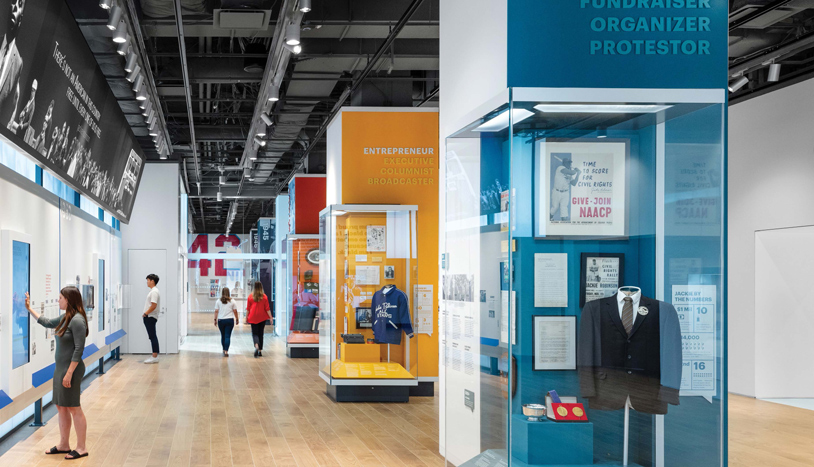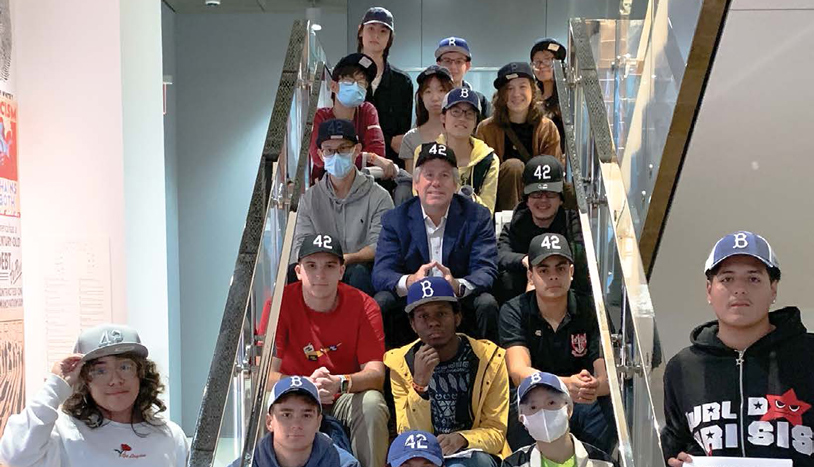The Jackie Robinson Museum: Honoring a Legend
Following years of planning, a museum dedicated to barrier-shattering baseball legend and civil rights icon Jackie Robinson is open in downtown Manhattan. In partnership with Zubatkin, Gensler, ME Engineering, and the Jackie Robinson Foundation (JRF), Structure Tone New York transformed the ground floor of 75 Varick Street, a landmark building, into The Jackie Robinson Museum.
“The Jackie Robinson Museum is the realization of a dream for my family. My mother has long hoped for a permanent space where people learn about the issues my father cared deeply about and the change he fought hard to affect,” said David Robinson in a statement. “We hope the Museum will be a place to not only learn more about his time in baseball and love of sports, but about all that he did to contribute to social progress. We extend our deepest appreciation to everyone who helped make this dream a reality.”
Adjoining the JRF offices—built by Structure Tone in 2009—the 19,000sf museum debuted in the summer of 2022 with an official ribbon-cutting ceremony and grand opening event. Leveraging Structure Tone’s previous experience in the space and client relationship with Gensler’s expertise in museum and digital experience design, the museum realizes JRF’s goal to preserve Robinson’s remarkable legacy as the first African American to play Major League Baseball in 1947, serves as a venue for conversations about social issues, and provides educational programming.
Mike Noblin, account executive, and Andrew Smith, project manager, have been part of this account since building the foundation’s offices over a decade ago. “The museum was a really exciting project to be a part of,” says Noblin. “Andrew and I were honored to work for the Jackie Robinson Foundation again. They’re one of the best clients we have.”

Building A Legacy
Featuring 4,500 artifacts and 40,000 historical images, the museum highlights the Brooklyn Dodgers legend and his contribution to both sports and life at large in a renovated space that features permanent exhibitions and interactive displays, flexible event areas with retracting walls, and a reference library. Construction of the space included additional facilities, such as a reception lobby with coat check, museum store and gift shop, pantry and warming kitchen, theater, and additional classrooms.
The outside of the museum is just as cool as the inside, with an outer glass façade and public entrances on both Canal and Varick Streets. To craft an exterior display, Structure Tone’s project team worked with the exhibit designers and specialty subcontractors to install an architectural metal pan ceiling to showcase polycarbonate panels with a graphic overlay—creating a custom scrim wall that wraps around the perimeter and is visible from Canal Street.
Structure Tone superintendent Mike Sansone describes the excitement driving the team on-site: “The most important thing was getting construction done before Rachel Robinson’s (Jackie’s wife) 100th birthday. That milestone dictated our schedule. As we inched closer to that date, we really stepped on the gas to get everything done.”
An Immersive Experience
For years, museums were experienced as cultural, historical vaults, with a “look, but don’t touch” policy. But today, people are realizing that museums serve a different purpose as places to discover the past firsthand. Working off Gensler’s design, the Structure Tone team built a space that incorporates a range of involvement, inspiring people to engage with history rather than merely observe it. It’s a true example of how impactful a cultural institution can be. Exciting and innovative exhibits, including a media-based experience featuring photographs, video clips, and additional memorabilia, allow visitors to better understand the racism and prejudice Robinson encountered on and off the baseball field. Self-guided touchscreens invitem visitors to interact with real-time polls and learn about Robinson’s lasting influence on sports, politics, and entertainment.
One of the coolest displays is an interactive model of Ebbets Field, home of the Brooklyn Dodgers. The reproduction of this famous baseball diamond uses storytelling projection that highlights various baseball memories, including famous World Series plays and Rachel Robinson’s seat during games. Another momentous exhibit, Living Legacy, uses personal interviews and firsthand accounts from 42 influential people, including fellow baseball players and former presidents, to describe Robinson’s life and the change he created.
Community Outreach
Enhancing its parent foundation’s mission of promoting higher education, the museum features over 11,000sf of permanent and rotating exhibitions to educate, inspire, and challenge people of all ages. The museum joins JRF Scholarship and JRF IMPACT, an online community for Black college students, as one of the foundation’s three core initiatives, and will host programs focusing on important issues such as civic affairs, economic empowerment, and educational access. Even the museum’s grand opening included several special events, including a block party and screenings of the History Channel documentary After Jackie.
Structure Tone New York is getting involved in community outreach at the museum too. Last fall, members of the Structure Tone project team, including Smith and project executive Stacey Dackson, brought a group of Boy Scouts Explorers downtown to tour the site. The Boy Scouts Explorers is a program which brings high school students into different types of business to learn about career choices. While visiting the museum, the teens learned about its construction, while also being led through the space by the Jackie Robinson Foundation’s Director of Operations LaTonya Johnson.
A Grand Slam
During construction, the team never lost sight of the fact that they were creating history. “This was the project of a lifetime,” expresses Dackson. “LaTonya [Johnson] and Della [Britton Baeza] from the Foundation dedicated so much time bringing this project to life and working to complete Rachel Robinson’s vision. I’m very proud of the role Structure Tone played.”
Sansone agrees, “Building this museum will be a part of my legacy, for my children and grandchildren. I never realized how impactful Robinson was in the civil rights movement; learning about him and what he stood for has started conversations and opened dialogue between me and my grandkids. I hope everyone in the city takes advantage of spending some time there.”

At the end of the tour, the group met with STO Building Group’s Executive Chairman, Jim Donaghy, who posed with them for a photo, all donning classic Brooklyn Dodger caps with Robinson’s immortal #42 on the front.
Smith recalls how engaged the group was during the tour, “The underlying message of civil rights meant a lot to these Explorers, many of whom are minorities or people of color who want to go to college and pursue a career in the industry.” Smith also notes how Structure Tone’s project team planned an activity to teach the Explorers about the museum’s construction. “Usually, the Explorers visit a site that’s still in progress, under construction. Since the museum was completed, we organized a sort of scavenger hunt. We showed them ‘before’ photos of various areas of the museum and they had to find the finished spots. It was a cool way to educate and entertain without being on an active jobsite.”
